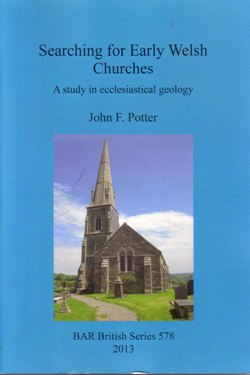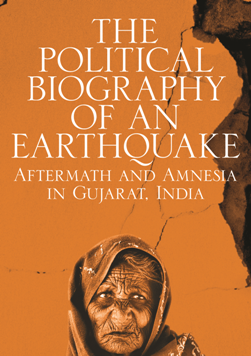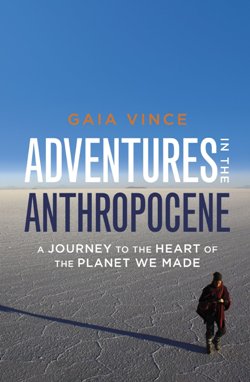 Searching for Early Welsh Churches
Searching for Early Welsh Churches
John Potter, compiler of this monumental survey of the ecclesiastical geology of ancient Welsh churches, is a phenomenon – a veritable octogenarian prodigy. Long-term readers of this magazine will remember perhaps their first exposure (so to speak) to the geological reading of ancient churches when they read his 2005 feature ‘Ecclesiastical Geology – a return to Victorian field standards’ (Geoscientist 15.10 pp4-7).
By that time Potter had already visited over 10,000 churches, extant and ruined, in the region of the Thames Valley, and had shown how the story of the ancient courses of the Thames and its tributaries was written into them – a story sadly no longer visible in working gravel pits. But because ancient buildings used materials on or close to site, they now provide windows into the geology concealed beneath.
Potter has also been using his geologist’s eyes to help archaeologists (whose lithological observations are generally woeful) recognise Anglo Saxon work where no definitive diagnostic architectural details survive: for example, in the ‘patterned’ use of stone in quoins, where Saxon work is discernible as alternating ‘long and short’ work.
Potter has since conducted extensive surveys of almost all ‘Anglo Saxon’ religious sites in England, and extended his researches to the ancient churches of Ireland, Scotland, the Scottish islands and the Isle of Man. Now, supported by a British Academy Research Grant, he has completed this mighty compilation of stonework in the churches of Wales – hitherto deemed a pre-Romanesque desert.
Faced with the less forthcoming Palaeozoic limestones and greywackes of Wales, and the lamentable practice of lime-washing and rendering encouraged there by CADW, Potter found greater difficulty than he expected in substantiating his contrary belief. Over 400 sites were examined, yielding perhaps over 30 with ‘patterned’ style fabrics recognisable from his previous work. This is, very largely, the first time that Welsh churches have been surveyed in this way, and his work has been able to explain much about the unique features of church building in the Principality, such as the wide variety of wall batters (castle-like thickening to the base).
I could point to more examples in areas where I personally happen to know the churches well; and I suppose every Welshman with a local patch (mine being Gower) could do likewise. But this is a stupendous achievement which, despite being a massive illustrated litany, also manages to be feisty, opinionated and readable. It is a most valuable addition to the growing literature of a subject still in its infancy.
Reviewed by Ted Nield
Searching for Early Welsh Churches – a study in Ecclesiastical Geology by John F Potter, Archaeopress 2013. 457pp sbk BAR British Series 578 ISBN 978 1 4073 1098 5 W: www.hadrianbooks.co.uk List Price: £64.00
 The Political Biography of an Earthquake
The Political Biography of an Earthquake
On India’s Republic Day in January 2001, a M7.7 earthquake struck the western part of Gujarat. It killed an estimated 14,000 people, mostly in the coastal region of Kutch, next to the border with Pakistan. It totally destroyed 178 villages, more than 70% of 165 other villages and damaged four major towns—Bhuj, Bhachau, Anjar and Rapar—seriously enough for emergency measures to be imposed on them. In Bhuj, there was an oil leak; at Kandla port, highly toxic chemicals leaked into the air, while coal dust and fluorspar spilled into intertidal waters at Navlakhi. Nine months later, partly as a result of the state government’s incompetence at reconstruction, the chief minister resigned, and was succeeded by a virtually unknown and unelected politician also from the Bharatiya Janata Party named Narendra Modi, who has now become India’s prime minister.
The Political Biography of an Earthquake is a revealing study of what has happened to the devastated area since 2001, based on a decade of field research beginning in the 1990s by Edward Simpson of London’s School of Oriental and African Studies. It attempts to answer the question that arises in the aftermath of any major natural disaster: to what extent has the post-disaster reconstruction changed and even benefited the area struck by it?
Under Modi’s chief ministership, Kutch has experienced a dramatic and much-reported spate of industrialisation, accompanied by extensive, if largely unreported, environmental degradation. According to Simpson, the earthquake’s destruction was one of the principal catalysts or ‘enablers’ of this rapid development.
Earthquakes have struck the region before. Unfortunately, the historical record is almost non-existent, with the exception of a 1956 earthquake centred on Anjar, and one in 1819 at the time of the British takeover of Kutch. This worked to the political advantage of the colonial power, but also threw up a natural dam, known as the Allah Bund, which diverted the waters of the River Indus and caused the fertile lands of Kutch to fail.
“As agricultural lands withered,” writes Simpson, “the population of Kutch turned to trade, commerce and international migration for its fortune”—thereby helping to generate a Gujarati diaspora with a commercial reputation evident in today’s Britain. Many of them donated handsomely to the reconstruction in 2001. But one cannot help wondering what will happen to Kutch’s burgeoning industries next time the Earth shakes.
Reviewed by Andrew Robinson
The Political Biography of an Earthquake: Aftermath and Amnesia in Gujarat, India
By Edward Simpson. Published by Hurst Publishers 2014 ISBN 978-1-84904-287-1 302 pages, List price £22.00
www.hurstpublishers.com
Jurassic Coast Fossil Finder
Chances are that the fossil you actually find is not one of those illustrated in the various fossil guides available, such as the excellent NHM handbooks. It is therefore useful to have a guide which figures specimens from the localities you may well have visited. The material from collections of museums across east Devon and Dorset are included in this compilation.
In addition to the fossils a wealth of information can be accessed from the website, including safety in the field, collecting, conservation, and even a selection of accommodation available in the area. But it is on the fossils that this guide must be judged; the colour photographs are excellent, but beyond this there are some serious reservations.
‘Search the database’ allows the user to select a fossil group and then scroll through fossils of a particular age. Thus, entering ‘ammonites’ reveals ‘252 fossils found’. Unfortunately the caption under each photo merely says ‘ammonite’; it would have been far more useful to have the generic name under each. Clicking on the photo may reveal a generic (with or without) a specific name, stratigraphical information and a locality. These are often from ancient museum labels, so identification is sometimes lacking or inaccurate and, totally un-necessarily, each bears an absolute age of the specimen. These are often wrong and it would have been far better to have a geological time-scale alongside the Heritage Coast succession and a few appropriate radiometric ages appended to that.
Some of the ‘scientific names’ are just nonsense, such as a leaf labelled as Angiosperm dicotyledon or a crinoid given the ‘scientific name’ Echinodermata crinoidea. These should have been checked before publication, as should the palaeontological howlers. Thus ‘Ammonites moved by sucking water through the mouth, pumping it over the gills, then squirting it out again’; ‘Bryozoans are colonial animals made up of many jellyfish or anemone-like polyps’ or ‘Bivalves shells are held together by a strong muscle, and hinged at the pointed end’. Such errors are further compounded by loose wording: such as in the statement that ooliths are composed of ‘layer upon layer of calcium’.
Proof checking has been poor throughout so that there are frequent mis-spellings, not only of technical terms such as phragmocone, ichthyosaur and Wealden, but even of words like ‘symmetry’.
Richard Edmonds, Jurassic Coast Earth Science Manager has said that he would ‘welcome any input that helps us enhance or improve the content’. Regrettably a great deal is needed and one is led to the conclusion that the site has been released prematurely.
Reviewed by John C W Cope
Jurassic Coast Fossil Finder website, published by Jurassic Coast Museums Partnership 2014. W:
www.jurassiccoast.org/fossilfinder
 Adventures in the Anthropocene
Adventures in the Anthropocene
Our world, we have always known, is changing. But now we realise that the Earth is changing, and that is a little different. It is becoming clear that humans have collectively refashioned the surface processes of this planet, to alter the course of its geological history. One response to this growing realisation is the suggestion that we no longer live in the Holocene, but in a new, human-driven epoch, the Anthropocene. It’s a term that now enjoys wide currency.
What is the Anthropocene world really like, though? Science editor and journalist Gaia Vince set off to find out, travelling the world to observe the human reality of living on a planet in transition. This book is an account of that journey. I approached it with trepidation - a book of this sort might easily descend into a combination of self-indulgent travelogue and dystopian forecast. I need not have worried. Gaia Vince, with her background at Nature, New Scientist and the BBC, has done her homework well (the scientific context is well explained) and picked her way deftly through the terrain.
The book is patterned on the Earth’s main geographic regions: rivers, deserts, forests, mountains, the oceans – together with our species’ own additions to geography, in the form of farmlands, mines and the burgeoning cities. Within this, Vince has targeted people and places that range from the remarkable – the retired engineer in the Himalayas, say, who is trying to re-grow mountain glaciers, or the man building a whole island out of rubbish in the Caribbean – to the commonplace of daily life in the slums of Latin America.
How are people coping in a world of growing populations, shrinking resources and changing climate? she asks. There is a keen focus on the practical, in this now tightly-coupled and increasingly rapidly evolving human-Earth-environment system, as to what might be done to nudge this new co-evolutionary system along a more hopeful path. That is, for its human component at least. Vince acknowledges that many of our kindred species – the coral reef communities, for instance – will probably not last the century. But people, she shows, can be remarkably adaptable.
The writing is vivid and pacy – nicely attuned in style with the breathless pace of global change. Like the best journalism, it gives a keen sense of people and places (think the excellent ‘From Our Own Correspondent’ of the BBC). Highly recommended.
Reviewed by: Jan Zalasiewicz
Adventures in the Anthropocene: a journey to the heart of the planet we made, by Gaia Vince Published by: Chatto & Windus 2014. ISBN-13: 978-0701187347 448pp hbk. List Price £20.00.